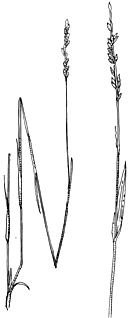
Description: Loosely tufted perennials with wiry, branched stems arising from a short rhizome.
Leaves with ligule a rim of short hairs; blade rolled in bud, involute, usually rather short, often with tubercle-based hairs, disarticulating at the ligule at maturity.
Inflorescence a primary axis with short racemes, branches erect, often with a few hairs in the axils of the spikelets.
Spikelets pedicellate, falling entire from the pedicel, usually solitary, adaxial, glabrous externally; florets 2, the lower sterile, the upper bisexual. Glumes unequal, glabrous, smooth, the lower 0–3-nerved, the upper glume the length of the spikelet, 5-nerved. Lower similar to the upper glume and slightly shorter than it; upper lemma pubescent with fine white hairs; margins partly enclosing the palea. Palea the length of the upper lemma, hairy on the back. Lodicules 2, broad-cuneate.
Distribution and occurrence: World: 5 species, Africa & Australia. Australia: 3 species (native), Qld, N.S.W.
Text by S. W. L. Jacobs & C. A. Wall
Taxon concept:
| | Key to the species | |
| 1 | Upper glume and lower lemma exceeding the fertile floret by up to 1 mm; leaves with blade flat and well-developed with a distinct midvein; spikelets 2.5–3.8 mm long | Entolasia marginata |
| Upper glume and lower lemma about as long as the fertile floret; leaves with blade slightly incurved to involute, sometimes very short and without a prominent midvein; spikelets 2.2–6 mm long | 2 |
| 2 | Spikelets 2.2–3.8 mm long; tufts of short leafy shoots often present at the nodes | Entolasia stricta |
| Spikelets 4–6 mm long; culms branched at the nodes but without tufts of short shoots
Back to 1 | Entolasia whiteana |
|


